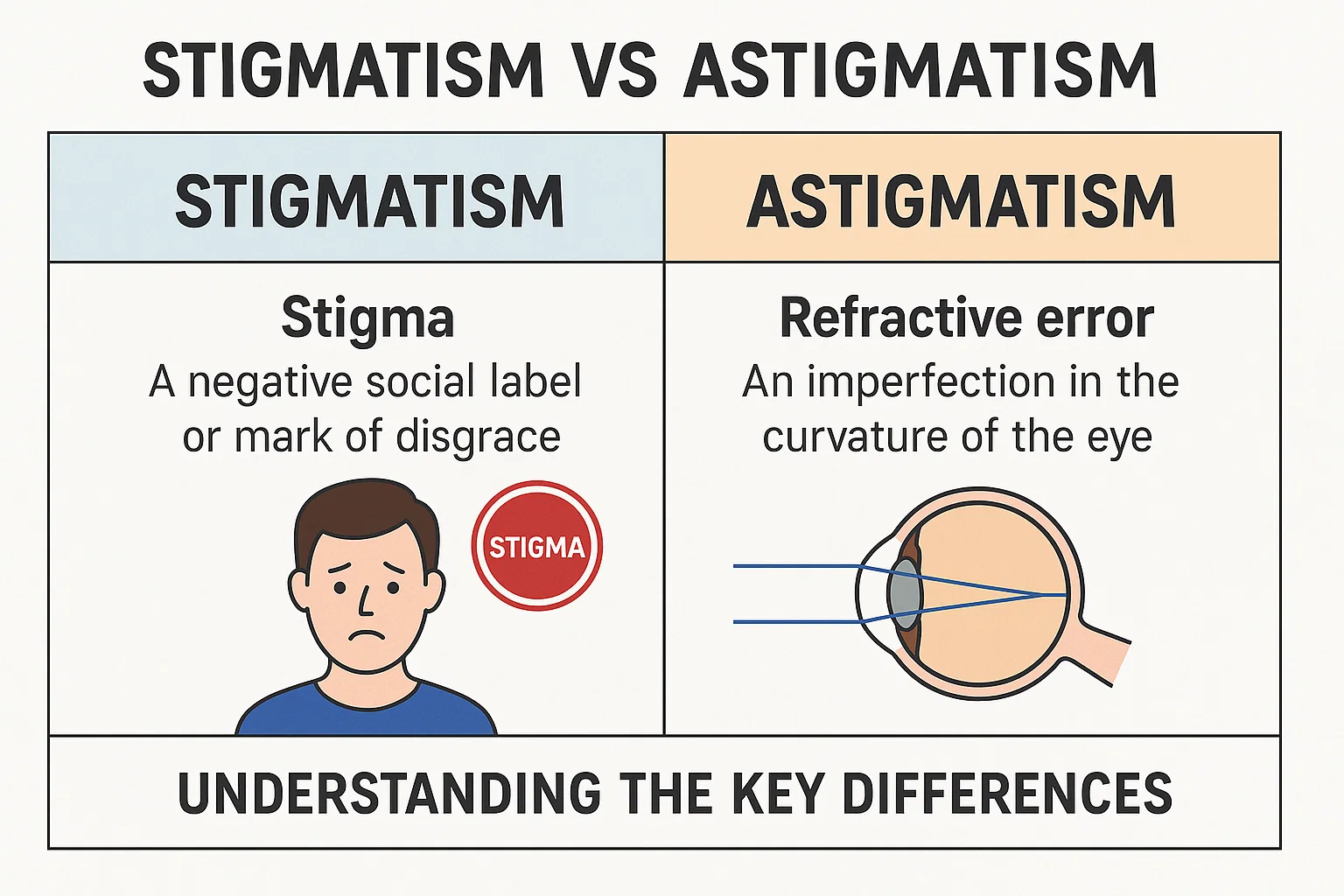Introduction
Vision health can often be misunderstood, especially when medical terms sound alike but mean different things. Two such terms that often confuse people are stigmatism and astigmatism. While they share some linguistic similarity, their meanings diverge widely. One relates to normal vision clarity, while the other describes a common eye condition that affects how light enters the eye.
Read more: The Complete Guide to Volvoer
What is Stigmatism?
The term stigmatism is not a widely used medical diagnosis in modern optometry. Instead, it is a theoretical concept in optics. In simple terms, stigmatism refers to normal or perfect vision in which light rays entering the eye converge accurately at a single focal point on the retina.
When the eye has stigmatism:
- Light focuses correctly.
- Vision is sharp and clear.
- No distortion or blurring occurs.
Optical science uses the word “stigmatism” to contrast with astigmatism. Therefore, in everyday conversation, people rarely use the term “stigmatism,” but technically, it denotes the absence of refractive errors such as astigmatism.
What is Astigmatism?
Astigmatism is a common refractive error of the eye where the cornea or lens is irregularly shaped. Instead of light focusing evenly at one point on the retina, it scatters into multiple points, leading to blurred or distorted vision.
Key characteristics of astigmatism:
- The cornea is shaped more like a football than a basketball.
- Light bends unevenly when entering the eye.
- Vision becomes blurry at all distances.
Symptoms of astigmatism include:
- Blurred or distorted vision.
- Eye strain or discomfort.
- Headaches, especially after reading or screen use.
- Squinting to improve clarity.
Astigmatism is very common and can appear alone or alongside other refractive errors like nearsightedness (myopia) or farsightedness (hyperopia).
Stigmatism vs Astigmatism: The Core Differences
To eliminate confusion, let’s compare stigmatism vs astigmatism directly.
| Aspect | Stigmatism | Astigmatism |
|---|---|---|
| Definition | A state of perfect focus where light converges at one point on the retina. | A refractive error caused by irregular curvature of the cornea or lens. |
| Usage | Rarely used in daily conversation; more of an optical concept. | A common eye condition diagnosed by optometrists. |
| Vision Quality | Sharp, clear, distortion-free vision. | Blurred, distorted, or stretched vision. |
| Cause | Absence of refractive errors. | Uneven corneal or lens curvature. |
| Treatment | No treatment needed. | Glasses, contact lenses, or refractive surgery. |
Causes of Astigmatism
While stigmatism doesn’t have causes (since it is the ideal state of vision), astigmatism has several contributing factors:
- Genetics – Astigmatism often runs in families.
- Irregular Corneal Shape – The cornea may be more oval than round.
- Lens Abnormalities – Sometimes, the lens inside the eye contributes to irregular light bending.
- Eye Injuries or Surgery – Trauma or certain eye surgeries may lead to astigmatism.
- Keratoconus – A rare condition where the cornea thins and bulges into a cone shape, causing severe astigmatism.
Diagnosis: How Are They Identified?
Since stigmatism indicates normal vision, no diagnosis is required. However, identifying astigmatism involves several clinical tests:
- Visual Acuity Test – Reading letters on an eye chart.
- Keratometry – Measuring the curvature of the cornea.
- Corneal Topography – Mapping the corneal surface in detail.
- Refraction Assessment – Determining the exact lens prescription.
Treatment for Astigmatism
Unlike stigmatism, which needs no intervention, astigmatism requires treatment if it significantly affects vision. Common treatment options include:
1. Prescription Glasses
Eyeglasses with cylindrical lenses correct uneven light refraction, improving clarity.
2. Contact Lenses
- Toric lenses are specially designed for astigmatism.
- Rigid gas permeable (RGP) lenses may also be used in some cases.
3. Refractive Surgery
Procedures like LASIK or PRK reshape the cornea to correct curvature.
4. Orthokeratology (Ortho-K)
Special rigid lenses are worn overnight to temporarily reshape the cornea for clearer daytime vision.
Misconceptions About Stigmatism vs Astigmatism
- “Stigmatism is an eye disease.”
- False. Stigmatism is not a disease; it’s a description of normal vision.
- “Astigmatism causes blindness.”
- Incorrect. While it causes blurry vision, astigmatism is correctable and does not cause blindness.
- “Astigmatism only affects adults.”
- Not true. Children can also have astigmatism, and early eye exams are important.
- “Wearing glasses makes astigmatism worse.”
- A myth. Corrective lenses improve clarity but do not worsen or improve the natural shape of the cornea.
Living with Astigmatism
People with astigmatism can lead normal, active lives once properly diagnosed and treated. Some practical tips include:
- Regular Eye Exams – To update prescriptions and monitor changes.
- Proper Lighting – Helps reduce eye strain while reading or working.
- Resting the Eyes – Taking breaks during screen use can reduce headaches.
- Using Corrective Lenses Consistently – Ensures optimal clarity and prevents discomfort.
Future of Vision Correction
Advances in technology are making it easier to correct astigmatism. Customized laser treatments, advanced contact lenses, and corneal implants are reshaping the way optometrists address refractive errors. With research progressing, patients have more choices than ever to maintain clear, healthy vision.
Conclusion
When comparing stigmatism vs astigmatism, the key lies in understanding that:
- Stigmatism is a concept describing perfect vision without errors.
- Astigmatism is a common condition where the cornea or lens causes light to scatter, leading to blurry vision.
Confusing the two is easy because of their similar sound, but they are essentially opposites—one denotes flawless focus, the other a refractive imperfection. Recognizing the difference empowers individuals to better manage eye health, seek timely treatment, and appreciate the value of clear vision.
FAQs About Stigmatism vs Astigmatism
Q1. Is stigmatism a real condition?
No. Stigmatism refers to normal, error-free focusing in optics. It is not a medical condition.
Q2. Can astigmatism go away on its own?
Astigmatism usually does not disappear naturally. It often remains stable or changes slightly over time, requiring corrective lenses or surgery.
Q3. How common is astigmatism?
Astigmatism is very common, affecting millions worldwide. Many people have it to some degree, even if mild and unnoticed.
Q4. Does astigmatism get worse with age?
Yes, it can change over time due to natural eye changes. Regular check-ups are essential to maintain clear vision.
Q5. What happens if astigmatism is left untreated?
Untreated astigmatism leads to constant blurry vision, headaches, and eye strain. It does not cause blindness but affects quality of life.
Q6. Can children have astigmatism?
Yes, children can be born with astigmatism. Pediatric eye exams help detect and correct it early.
Q7. Are there permanent cures for astigmatism?
Refractive surgeries like LASIK can provide long-term correction, though not everyone qualifies.
Q8. Does using screens cause astigmatism?
No, screen use doesn’t cause astigmatism. However, it can worsen symptoms like eye strain and headaches in people who already have it.









